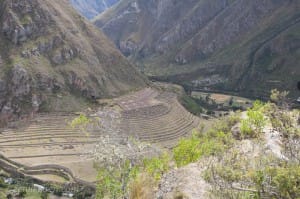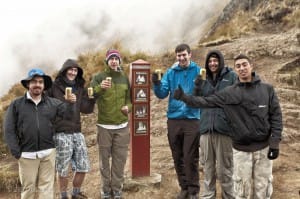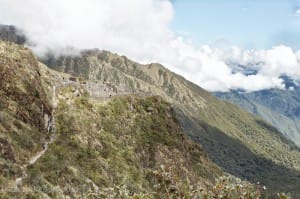The Inca Trail is hands down the best travel adventures I have had to date. It is everything you have ever read about and more. It was almost like we ourselves had traveled back in time and were pilgrims making the trek to the sacred Machu Picchu. The experience of making friends with total strangers just further added to the allure of the trek. I’ve summarized the hike below. For more information on how I actually planned and booked my trek, see my previous guide.
The Hike Itself
Day 1 of the Inca Trail
 The day started with our trekking company picking us up from our hotel early in the morning and a bus ride to the head of the trail, stopping along the way for breakfast and last-minute supplies.
The day started with our trekking company picking us up from our hotel early in the morning and a bus ride to the head of the trail, stopping along the way for breakfast and last-minute supplies.
Once we got on the trail, it was relatively flat and easy. We stopped several times along the trail for our guide to explain the history and significance of the Inca Trail. The trail was used during the ancient times by pilgrims wanting to visit the sacred Machu Picchu (A more direct path was used for supplies). Winding through the Andes Mountains the trail passes several ruins that were once used by the pilgrims to stay and worship.

One of the first ruin sites we visited was Llactapata which, in Quechua, means the town on hillside.
Llaqtapata are ruins constituted by a village and farming terraces and are located on the banks of the Cusichaca River.
Llaqtapata is located between the Cusco and Machu Picchu on a stone-paved Inca highway, part of the Royal Road that climbed and twisted more than 5,000 miles through the Andes. Llaqtapata was burned by Manco Inca Yupanqui, who destroyed a number of settlements along the Inca trail during his retreat from Cusco in 1536 to discourage Spanish pursuit. In part due to these efforts, the Spanish never discovered the Inca trail or any of its settlements.
After our brief history lesson we continued on to lunch, which our porters had run ahead and set up during one of many stops.
Let me get this out-of-the-way for anyone thinking we would be eating simple, cook site type meals. Our trekking company (and I’m sure all are like this) had our own chef. The chef on Peru Treks was nothing short of phenomenal. Lunch that day was a three course meal consisting of some of the best guacamole I’ve ever had, a hearty soup, and I think a chicken main meal. Wow! Is all I can say. Our meals were different every day and all consisted of three courses. Needless to say we ate well!
We continued hiking after lunch and ended up at our campsite. The campsite was, of course, already set up for us. We stayed the night at the Wayllabamba campsite. Dinner was served and, of course, it was great. This was the first night we got to spend meeting the other people on our hike.
There were 14 people on our trek and ages ranged from the youngest at about 12 to the oldest at around 50. Everyone got along and the experience of bonding over those 4 days with complete strangers was part of the allure of the trek. You can easily take the train and see Machu Picchu, but hiking the Inca Trail and becoming great friends with total strangers gave me an experience I will never forget.
Day 2 of the Inca Trail
Day two become dramatically more difficult than the first day as we started to ascend into the mountains. We were woken up early, around 7am, by our porters with some hot, steaming cocoa tea.As the morning was cold, the cocoa tea helped warm us for our oncoming hike. Cocoa leaves also help counter the effects of altitude sickness so it was crucial we drink this every morning. After breakfast we continued on to the trail.
As the morning was cold, the cocoa tea helped warm us for our oncoming hike. Cocoa leaves also help counter the effects of altitude sickness so it was crucial we drink this every morning. After breakfast we continued on to the trail.
The target for the day was Abra de Huarmihuanusca which is Quechua for Dead Woman’s Pass. Dead Woman’s Pass is the highest point on the Inca Trail at 4215 meters (or 13650 feet) above sea level. It takes its name from the arrangement of the terrain which is said to represent a woman lying on her back.
On the hike up we stopped at one of the many “stations” where locals sells things like candy bars, toilet paper, and picked up some beers. The hike itself was probably the most difficult part of the trek. A steep grade combined with the weight of my pack caused me to question my ability to make it several times. The views from the top provide excellent views of nearby mountains such as Salkantay and Veronika (See my photo from Saturday) and was the perfect place to drink our celebratory beers. Needless to say that beer was amazing.
Day 3 of the Inca Trail
Day three started early again with cocoa tea served in our tents. Day three, while strenuous, proved to be my favorite day. The terrain became much more pronounced and the views were breathtaking.
After the hike up to Runkuraqay, we made our way to one of my favorite ruins along the trail – Sayacmarca. Sayacmarca, Quechua for Dominant Town, was originally built by the Qulla as a strategic fortress at the fork of two Inca roads. It was later improved upon by the Incas where they incorporated an ingenious canal system to give the site running water. While the area prevents farming, storehouses were used to keep fresh food for the occupants.
After our history lesson, we continued on our trek to lunch and then to my all time favorite ruin along the Inca Trail: Wiñay Wayna (Quechua for Forever Young).
These ruins were only discovered in 1941 and are built into a steep hillside overlooking the Urubamba River and the Sacred Valley. While not much is known for Wiñay Wayna’s exact purpose, the site’s lookout nature, its positioning near the important Inca access road, and the investment represented by it’s architecture suggests its a place of some importance during the Incas. The views from here were breathtaking and probably one of my favorite moments on the trail.
We continued on after a brief moment of reflection. This was our last full day of hiking – we were all excited for what Day 4 would bring: Machu Picchu!
Our guides had one last surprise for us – the cooks made us a cake! I’m still not 100% certain how they managed to bake a cake – but it was delicious.
This was our last night with our porters. We enjoyed our cake and performed the tipping ceremony. Our guides and porters were amazing and deserved every dollar they got.
We went to bed early that night as wake up for the following morning was going to be before dawn. We had to make Inti Punku (The Sun Gate) by sunrise to catch the first glimmer of light striking Machu Picchu. Needless to say it was hard to get to bed that night but well worth it. The views we saw the next day were out of this world.















The name of the sun gate is: Inti Punku. thanks for your report. I´ll be walking that road on March next year.